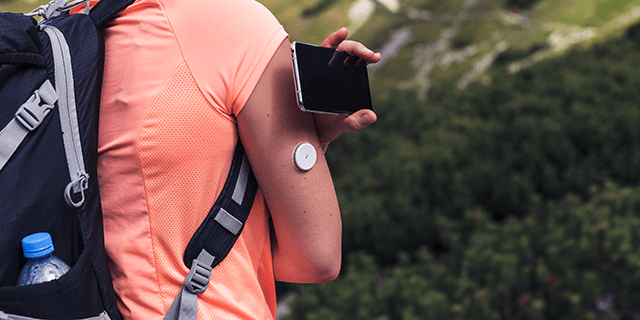
Exercising is one of the most common recommendations health experts give for reducing your blood sugar levels. But, they also say that exercise can cause your blood sugar levels to spike. So, which statement is true?
Both, actually. Understanding why this is the case, though, is a key part of managing your metabolic health. It’s especially important if you have prediabetes or a strong family history of diabetes. That’s because exercise has the power to help prevent or delay prediabetes from progressing into type 2 diabetes, making it a reversible condition!
Exactly how exercise alters glucose levels can be different for everyone. The effect can change depending on the type, duration, and intensity of the physical activity as well as your diet and overall health status. So, when it comes to blood sugar and exercise, the relationship is complex.
Our goal is to help you find a signal in the noise that will guide you toward taking control of your blood sugar levels. Because when you do, you can reap the benefits of optimal metabolic health.
The best way to understand exercise and blood sugar’s relationship is to jump right into the science.
Does exercise impact your glucose levels?
The American Diabetes Association advises that exercise can lower your blood sugar levels for up to 24 hours (or more) because:
Your muscle cells use available insulin more efficiently, meaning you increase your insulin sensitivity (more on this later). Your muscles use more glucose during exercise than when they’re resting. This greater uptake of blood sugar into your muscle cells naturally lowers blood sugar levels.
But, your blood sugar levels will respond differently while you’re exercising than they will over the long term. Let’s unpack the differences by looking at each.

How exercise impacts glucose in the moment
When you exercise, your body relies on two sources of fuel: glucose and fat. How your blood sugar changes during exercise depends on the intensity level of your workout and the fuel source your body is using.
Steady-state cardio exercises, like jogging or gentle swimming, don’t rely on your body having to produce quick bursts of energy. In these cases, it gets more of its energy from fat, so your blood sugar will usually stay at the same level or decrease.
Higher-intensity exercises like HIIT, strength training, and sprinting cause your body to release a surge of adrenaline. To ensure that you have enough energy readily available for this, your body releases glucose from your liver, increasing your blood sugar levels.
Put more simply, your body works through exercise using supply and demand. During high-intensity exercises, it doesn’t have the supply of energy on hand to fuel your workout. So, it releases glucose, immediately meeting the energy demand to fuel your workout while causing a short-term spike in blood sugar. During low-intensity exercise, your body has enough energy on hand to meet the demand, so blood glucose typically stays steady or decreases.
Short-term level changes like these are not harmful, just a standard part of our physiology.

How exercise impacts glucose in the long term
There are no two ways about it. Even with the odd glucose spike, exercise is beneficial to your blood sugar levels in the long term. According to the American College of Sports Medicine and the American Diabetes Association, all exercise forms improve insulin sensitivity and blood sugar control.
But why does exercise have such a positive impact on your blood sugar levels? Let’s delve into the science a bit further, shall we?
Why is exercise so important to your glucose levels?
Several physiological processes occur during exercise that lead to reduced blood sugar levels:
Increased glucose uptake without extra insulin
When you have just eaten or are resting, glucose uptake into your muscles relies on insulin. If your blood sugar level rises (like after eating a meal loaded with carbs), it stimulates insulin release. The insulin then acts on your cells to use or store the excess glucose.
The uptake of glucose is much different when you are exercising. According to the American Journal of Physiology, exercise increases muscle glucose uptake up to 100-fold compared to being at rest!
And, this uptake does not rely on insulin. Scientists suggest that it is due to a protein called glucose transporter type 4 (known as GLUT4). But even they are still figuring out exactly how it happens.
It’s important to note that the muscle glucose uptake that happens during exercise can still occur in people who suffer from insulin resistance and diabetes. In this case, it acts as an effective lifestyle treatment for anyone with these conditions. And, as mentioned at the beginning, exercise can reverse insulin resistance and prediabetes. Pretty great, right?
Mitochondrial function and health
Most human cells contain tiny organelles called mitochondria. They are the “powerhouse” of the cell, generating the cell’s energy currency known as adenosine triphosphate (ATP). These tiny powerhouses convert chemical energy into energy that the body can use by turning glucose into oxygen and ATP.
Research published in the journal Cell Metabolism shows that exercise increases the number of mitochondria in the muscle cells. Not only that, but it causes them to function better too! The more efficiently they work, the better you perform. More mitochondria mean your cells turn more glucose into energy. This makes your body more insulin sensitive. So, through exercising, you are helping to lower your risk of diabetes.

Reduced adipose cell size
Obesity is a known risk factor for developing diabetes and heart disease. Actually, it’s the leading risk factor for developing type 2 diabetes. Fact. And, if you carry that extra fat around your abdomen, you are at a much higher risk of all-cause mortality than people who store their excess fat in their thighs.
Exercise reduces fat cell size, specifically abdominal fat cells. A study published in the International Journal of Obesity showed that women who both dieted and exercised had an 18% reduction in the size of abdominal fat cells compared to those that relied on diet alone.
Why is this important? A reduction in fat cells’ size improves insulin sensitivity, lowers blood sugar levels, and reduces the risk of developing diabetes.
Improved fat oxidation
Fat oxidation means “to burn” fat. It is the ability to use fat, rather than carbohydrates, as fuel. Now, there is a lot of debate about the intensity level and exercise duration required to achieve optimal fat oxidation. This is a pretty huge topic to cover, so we’re not going to dive into this fully here.
But, what scientists have proved is that the best way to increase the fat burning process is to exercise regularly. Fat burning depends on several things, including the number and quality of mitochondria. Yes, we are back to those little powerhouses. And, as we already know, exercise increases both the amount and quality of mitochondria, resulting in improved fat oxidation.
The more fat you burn, the more you improve your insulin sensitivity, lower your blood sugar levels, and reduce your risk of diabetes.
Clearing glycogen stores and increasing glycogen accumulation after exercise
When you deplete your glycogen stores through exercise, you increase your available storage space for future incoming glucose. This increased availability is something that you can take advantage of. You can replenish your glycogen stores by eating carbohydrates while minimizing your glucose responses and fat gain.
You may have had a sports coach or trainer tell you to eat carbohydrates immediately after exercise. That’s because by doing this, you stabilize your blood sugar levels and enhance muscle glycogen recovery. This is a great technique for athletes, but also a great trick for us to have more flexibility in our diets.
Choose the correct type of training to deplete your glycogen stores (such as resistance training) to take full advantage of the increased storage space and improve your metabolic flexibility.

Metabolic flexibility
One of the biggest roadblocks preventing metabolic flexibility for most is being physically inactive. Having good metabolic flexibility means your body can easily switch between breaking down carbs or fat for fuel.
Different types of workouts assist in your body becoming more metabolically flexible. Mitochondria play a vital role in determining metabolic flexibility, and exercise helps increase the number of mitochondria you have.
Exercise also promotes anabolic flexibility (better ability to store or use glucose), which again, leads to improved metabolic flexibility.
Regardless of the type of exercise, staying physically active can help improve metabolic flexibility and protect against the development of metabolic disease.
The only way to track metabolic flexibility and how your blood sugar levels react to exercise is to use a medical device called a continuous glucose monitor (CGM). This monitor shows your blood glucose levels in real-time. As an example, say your CGM shows that exercise has a noticeable effect on your blood sugar levels. Once you’ve seen it, you can make changes to manage the glucose level difference. This ensures it has minimal impact on your body, helping you maximize your performance.
See how you can track your glucose levels in real-time Not sure where to start with using a CGM to monitor your blood sugar levels? Sign up for the NutriSense program and you can begin your journey using the latest CGM technology. As a program member, you’ll have the advantage of access to registered dietitians who can help you manage your glucose levels during exercise. Sign up to get started. What types of exercises have a positive impact on glucose levels?
The relationship between exercise and blood sugar is a positive one. That is clear to see. But, this relationship does change depending on the type of exercise you do and if you have diabetes.
Let’s look at how a few different types of exercise can affect your blood sugar levels.
Strength training
Strength training includes exercises like weightlifting (free or machine), bodyweight exercises, and resistance bands to build muscle strength, mass, and endurance.
Strength training is anaerobic. When you work out anaerobically, your body uses glucose as your primary energy source. It breaks down glucose without using oxygen. This provides you with high bursts of energy over short periods.
The American Diabetes Association advises that anaerobic exercise improves blood sugar control and insulin sensitivity. Research published in the International Journal of Cardiology suggests that strength training can provide more effective blood sugar regulation than cardio in people with type 2 diabetes.

Additionally, engaging in strength training helps to build our lean muscle mass. Glycogen, that glucose storage space we touched on earlier, can be stored in only the liver or the skeletal muscle. So the more muscle mass you have, the more potential storage capacity you have for incoming glucose. This equals out to lower and more controlled blood glucose values.
Keep in mind, though, that intense strength training is one of the activities that can cause your blood sugar levels to rise post-exercise. Remember that this rise is not a negative thing, and glucose values will usually go down again about an hour later. In the end, the benefit of the anaerobic exercise far outweighs the glucose spike.
Zone 2
Zone 2 is aerobic exercise. Aerobic exercise is cardiovascular training that increases your heart rate and breathing for sustained periods.
Zone 2 training is a type of heart rate training. It uses your maximal heart rate (MHR) as a guide for the intensity of the activity. There are five zones in total, ranging from very light to very hard intensity. Zone 2 is light intensity aerobic exercise where your heart rate sits at 60-70% of MHR.
When training in zone 2, your body optimizes using both fat and glucose for fuel. It achieves the highest amount of fat-burning for energy and improves the function of mitochondria.
You get the maximum effect of this type of cardio training by doing it regularly. The effect is cumulative, and over the long term, it significantly helps blood sugar control.

HIIT
High-intensity interval training (HIIT) combines both aerobic and anaerobic forms of exercise. It alternates more extended periods of cardio with short bursts of high-intensity activities. In other words, HIIT gives you the best of both worlds!
Through research published in the Scandinavian Journal of Medicine & Science in Sports, scientists identified that HIIT rapidly increases insulin sensitivity and glucose metabolism in the muscles of people with type 2 diabetes.
Thanks to the wide variety of exercises available under the HIIT workout umbrella, you can easily tailor this method to suit your lifestyle while reaping the benefits of glucose control and shedding abdominal fat.
Walking
Never discount the positive effect a stroll in the park can have on your health. Walking causes your heart to beat a little faster and your breathing rate to increase. This is going to promote your muscles to use more glucose and helps regulate your blood sugar levels.
In fact, a study published in Diabetes Care shows that three short 15-minute walks a day are as effective at lowering blood sugar levels as one long 45-minute walk at the same pace. The same study states that completing a short walk after your evening meal has the most significant effect on regulating your blood sugar levels.
Remember, exercise does not have to be vigorous to be impactful. Walking is an effective physical activity to help control your blood sugar levels. So, even a brisk walk after dinner can make a big difference to your metabolic health.

Mobility/Stability
Stability exercises improve flexibility and balance. These types of exercises include yoga, tai chi, stretching, and balance training. These activities can certainly have a positive effect on blood sugar control.
As discussed in the International Journal of Yoga Therapy, studies have shown that yoga, in particular, is very beneficial in reducing blood sugar levels. This is due to its combination of anaerobic exercise mixed with stress-relieving practices. It helps to reduce rising levels of cortisol, therefore controlling the rise in blood sugar levels.
Because stability exercises are easily adaptable and less strenuous, they’re an excellent option for people who cannot carry out higher-intensity exercises.
What types of exercises have a negative impact on glucose levels?
The positive effects of exercise on blood sugar control are clear. But, are there negatives that you need to consider? In short, not really. However, there are a few things to keep in mind to exercise safely. Let’s look at this in a bit more detail.
For non-diabetics and those without long-term health issues
If you are healthy and have no underlying health conditions or concerns, all exercise types are beneficial. That is a fact.
There are a couple of things to look out for to maximize your performance and metabolic health. As mentioned, high-intensity workouts can cause a blood sugar spike. Based on their years of clinical experience, our dietitians and clinical healthcare advisors advise trying to avoid a spike going over 180 mg/dL. That’s because abnormally high glucose spikes like these can potentially damage blood vessels.
Once you know how your body responds to exercise, you can prevent blood sugar spikes. If you do find that you have a considerable glucose response to exercise, pay attention to your pre-workout fueling, hydration, and electrolyte intake.
Below are a few top tips for managing your blood sugar levels during and after exercise:
Measure your blood sugar levels before, during, and after exercise. Get to know your normal levels and learn to identify trends. Eat a small snack before working out (a mix of fat, protein, and carbohydrates is best). Stay hydrated throughout your workout. If your blood sugar drops after you exercise, try grabbing a carb-based snack to eat immediately.

For diabetics
If you have diabetes, all forms of exercise are highly beneficial. But, there are extra precautions to take when exercising.
To ensure you exercise safely, check your blood sugar levels before, during, and after working out. It’s also worth seeking medical advice if you want to start a new or particularly intense exercise regime.
Never exercise if your blood sugar levels are too high or too low before you start. This is because it can raise or lower your blood sugar levels even further, potentially causing you to become unwell.
Hyperglycemia (high blood sugar)
If your blood sugar is higher than 250 mg/dL (13.9 mmol/L), it can be unsafe to exercise. Prioritize bringing your blood sugar levels down before training.
If you have high glucose levels and no insulin in your system, your blood sugar levels during a workout will soar. This also puts you at risk of diabetic ketoacidosis, a potentially life-threatening state where your body breaks down fat too fast. Generally, it’s safe for most people with diabetes to exercise with a blood sugar reading between 100 to 250 mg/dL (5.6 to 13.9 mmol/L).
High-intensity forms of exercise can also cause an excessive glucose spike. This is something to be particularly aware of if you have diabetes, especially type 1 diabetes, or use insulin medication.
In the case of type 1 diabetes, the body cannot increase insulin levels to deal with the glucose spike. So it’s essential to monitor glucose levels more often during high-intensity exercise, keep them within safe limits, and adjust insulin doses accordingly.
Hypoglycemia (low blood sugar)
If you are diabetic and your blood sugar levels are anything lower than 70 mg/dL (3.9 mmol/L), it could be too low to exercise safely. Try eating a small snack to boost your blood sugar, then re-check your levels before exercising.
Low blood sugar can also be a concern when working out, especially if you exercise for an extended period. It’s certainly worth bearing in mind if you are increasing the duration or intensity of your regime.
Check your blood sugar levels throughout exercising and lookout for signs of hypoglycemia, such as:
Blurred vision Shakiness, dizziness, or feeling lightheaded Confusion and difficulty concentrating Headaches Irritability and anxiety Excessive, heavy sweating Blood sugar levels of 70 mg/dL (3.9 mmol/L) or lower
If you become hypoglycemic during exercise, stop exercising and follow the 15:15 rule:
Consume 15 grams of carbohydrates (like a glucose gel tube or tablet) Wait 15 minutes Measure your blood sugar again Repeat until your blood sugar levels reach a minimum of 70 mg/dL (3.9 mmol/L)

How to monitor your glucose levels during exercise?
By measuring your blood sugar levels before, during, and after exercise, you can analyze your body’s response. Understanding how your glucose levels change during exercise helps you exercise safely, reach your best performance, and meet your health goals.
The only way to monitor your glucose in real-time is to use a CGM. A CGM gives you continuous blood glucose data that can help you identify deviations from normal. By accessing this data, it puts you in control of your own body.
How does a CGM work?
You place a small CGM sensor on the back of your arm and wear it for 14 days. Once in place, the CGM sensor will track your glucose levels at all times. Simply scan the sensor with an app on your smartphone and immediately you’ll have access to your real-time glucose levels. This lets you see for yourself how your glucose levels react to specific foods, stress, or exercise. Then, you can make positive changes to your lifestyle based on your own body’s data.
CGMs can help reduce the risk of glycemic variability (swings in glucose levels), hyperglycemia, and hypoglycemia, enabling you to reach optimal metabolic health.
To take this one step further and take the complexity out of glucose management, NutriSense combines CGM technology with clinical support from registered dietitians. This means you have access to clinical experts to guide you through your glucose management.
See how exercise affects your glucose levels in real-time Start your journey toward metabolic health by using a CGM. Track and analyze your body’s response to glucose during exercise, then understand the data with the help of personalized nutritionists. Sign up today.




